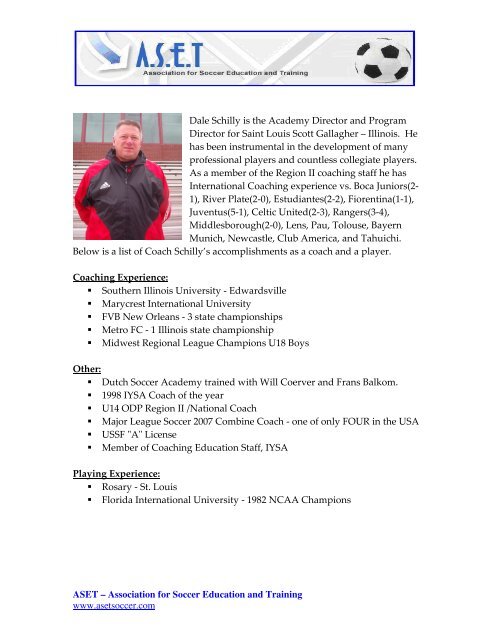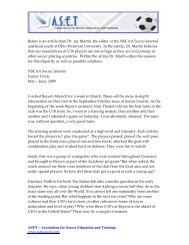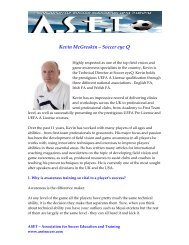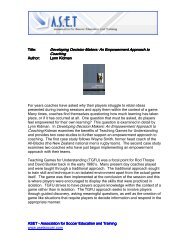Dale Schilly (partial interview) - Association for Soccer Education ...
Dale Schilly (partial interview) - Association for Soccer Education ...
Dale Schilly (partial interview) - Association for Soccer Education ...
Create successful ePaper yourself
Turn your PDF publications into a flip-book with our unique Google optimized e-Paper software.
<strong>Dale</strong> <strong>Schilly</strong> is the Academy Director and Program<br />
Director <strong>for</strong> Saint Louis Scott Gallagher – Illinois. He<br />
has been instrumental in the development of many<br />
professional players and countless collegiate players.<br />
As a member of the Region II coaching staff he has<br />
International Coaching experience vs. Boca Juniors(2-<br />
1), River Plate(2-0), Estudiantes(2-2), Fiorentina(1-1),<br />
Juventus(5-1), Celtic United(2-3), Rangers(3-4),<br />
Middlesborough(2-0), Lens, Pau, Tolouse, Bayern<br />
Munich, Newcastle, Club America, and Tahuichi.<br />
Below is a list of Coach <strong>Schilly</strong>’s accomplishments as a coach and a player.<br />
Coaching Experience:<br />
Southern Illinois University - Edwardsville<br />
Marycrest International University<br />
FVB New Orleans - 3 state championships<br />
Metro FC - 1 Illinois state championship<br />
Midwest Regional League Champions U18 Boys<br />
Other:<br />
Dutch <strong>Soccer</strong> Academy trained with Will Coerver and Frans Balkom.<br />
1998 IYSA Coach of the year<br />
U14 ODP Region II /National Coach<br />
Major League <strong>Soccer</strong> 2007 Combine Coach - one of only FOUR in the USA<br />
USSF "A" License<br />
Member of Coaching <strong>Education</strong> Staff, IYSA<br />
Playing Experience:<br />
Rosary - St. Louis<br />
Florida International University - 1982 NCAA Champions<br />
ASET – <strong>Association</strong> <strong>for</strong> <strong>Soccer</strong> <strong>Education</strong> and Training<br />
www.asetsoccer.com
What are the benefits, not only to the players involved in Academy League but<br />
also to the clubs involved in the USSF Academy League?<br />
For the clubs involved in the Academy League, the benefits are numerous, too<br />
many to list here. Perhaps the two most relevant are the impact on the Academy<br />
players directly and the affect the Academy has on the younger players due to<br />
the Academy experience of the older player.<br />
The rate at which players develop in the Academy environment is significantly<br />
increased. Simply put, the improvement is dramatic. When players compete<br />
against only elite level players on a daily basis in training and a weekly basis in<br />
matches, the individual weaknesses of all players are exposed. Every moment,<br />
whether game or training, is a test and if players have a deficiency in any of the<br />
four components of the game it is very apparent. This is the optimal<br />
environment <strong>for</strong> the player who is committed to taking the next step because it<br />
allows them to work on their issues, rather than masking those issues which<br />
occurs when elite level players train and play against lesser players. Due to the<br />
competitive nature of the league, the best players play. If a player is<br />
disappointed by their place in the team, it is their responsibility to commit more<br />
to their own development. We have definitely found that players improve more<br />
when faced with disappointment than when given false hope. Honesty and<br />
placing the impetus with the player to take responsibility <strong>for</strong> their own<br />
development helps to expedite the development process.<br />
At this level, the game truly sorts out the players. Some players think they desire<br />
to reach the next level, but when presented with the challenges of the<br />
environment, are unable to adapt in a way that allows them to address the<br />
deficiencies in their game. These players struggle and the environment proves to<br />
be too much <strong>for</strong> them and are eventually released from the academy because<br />
they cannot meet the demands of the sport at this level. It should be said that<br />
there are very good players who are released from the Academy. These are not<br />
bad players, but the Academy is only <strong>for</strong> the very best. The fact is the Academy<br />
is composed of the top players in the entire United States and, there<strong>for</strong>e,<br />
Academy programs must be composed of the absolute best players within a<br />
geographic region. The Academy is very competitive; every game in the 30 game<br />
ASET – <strong>Association</strong> <strong>for</strong> <strong>Soccer</strong> <strong>Education</strong> and Training<br />
www.asetsoccer.com
schedule is fought fiercely as 3 points are cherished! The players who have<br />
committed to the league are very competitive by their very nature and work very<br />
hard day in and day out in training to earn the three points on the weekend.<br />
Very early in the year, players learn that games are won on the training pitch<br />
be<strong>for</strong>e the weekend. This brings a level of intensity to every single training<br />
session that, in the old <strong>for</strong>mat, was only seen a week or two be<strong>for</strong>e State Cup or<br />
Regionals. Now this intense developmental environment is in place <strong>for</strong> 6-7<br />
months! The Academy environment is as close to a pro environment as one can<br />
replicate <strong>for</strong> youth in this country.<br />
The Academy also helps our younger players. Our younger kids are getting<br />
better because of the experiences of the older kids and the lessons learned by our<br />
staff in the Academy environment. As I said earlier, deficiencies are exposed in<br />
all of the players in an environment where the player has to commit to dealing<br />
with those issues. The player and the coach have to work together to<br />
overcoming the problems. From a larger development perspective, it is the<br />
Academy Staff’s responsibility to look at the deficiencies of the players who are<br />
currently in the Academy, in general, and take measures to ensure that the next<br />
generation of Academy players are prepared in a way that addresses those<br />
weaknesses prior to entering the Academy, thereby making them more prepared<br />
<strong>for</strong> the Academy experience. Over the course of this winter and spring, we have<br />
rewritten our curriculum based on the issues that became visible when our<br />
players started to compete against the best players in the country.<br />
What are your thoughts regarding the USSF showcase events as well as the<br />
coaching education weekends?<br />
The Showcases are incredible. There is not a detail <strong>for</strong>gotten, the players are well<br />
taken care of by the Federation and the atmosphere is perfect <strong>for</strong> the quality of<br />
player involved. There are over 200 college coaches at the Academy Showcases;<br />
that number dwarfs other Showcase events. On top of the college presence, a<br />
National Team coach scouts every game and provides detailed written feedback<br />
to each team after the event. Nike attends the events and completes SPARQ<br />
testing. Player’s scores are entered into a national database where college<br />
ASET – <strong>Association</strong> <strong>for</strong> <strong>Soccer</strong> <strong>Education</strong> and Training<br />
www.asetsoccer.com
coaches, national staff and professional coaches can then compare Academy<br />
athlete’s level of athleticism to each other. Gatorade provides free product and<br />
per<strong>for</strong>ms Hydration Testing to ensure athletes are properly hydrated <strong>for</strong> peak<br />
per<strong>for</strong>mance. Finally, to give kids a break from the soccer, there is a player<br />
lounge with fruit, Gatorade and something called XBOX, which the kids seem to<br />
like.<br />
Coaching <strong>Education</strong> comes in several <strong>for</strong>ms on the Showcase weekends. As<br />
mentioned above US National Staff coaches evaluate every game and provide a<br />
written report, but they also sit with you immediately following the game to<br />
discuss their thoughts. Having that immediate feedback is invaluable. Secondly,<br />
Academy club coaches can accompany US National Staff coaches while scouting<br />
games. This allows <strong>for</strong> interaction and additional insights from the perspective<br />
of the national staff. At the Winter Showcase in Lancaster this past December,<br />
the U23 National Team Goalkeeper Coach presented a session on a component of<br />
goalkeeping that scouts had identified as a problem amongst many goalkeepers<br />
in the Academy. Finally, US Youth National Team coaches do pre and post<br />
game talks around their exhibition matches. The last Showcase in Sarasota, both<br />
the U17 and U20 National coaches gave clinics around their exhibition matches.<br />
In the past, we never had this level of access to our national teams and staff.<br />
As a result of the limited substitution rule and the number of quality matches,<br />
in your opinion, what are the tactical trends emerging throughout the<br />
Academy League?<br />
Different regions of the country are learning different things. Because of the vast<br />
nature of America and the various influences that each region offer,<br />
environmental, cultural, socio economic, etc., the game is played differently from<br />
coast to coast. For us there are two areas that I see dramatic change. First, can<br />
the team take care of the ball and still have an end in mind. Secondly, can you<br />
defend collectively, and can it be sustained <strong>for</strong> a full match.<br />
ASET – <strong>Association</strong> <strong>for</strong> <strong>Soccer</strong> <strong>Education</strong> and Training<br />
www.asetsoccer.com
If you cannot take care of the ball, at the Academy level you end up chasing it <strong>for</strong><br />
a great majority of the game. Obviously, the team cannot physically sustain itself<br />
when defending <strong>for</strong> long, long periods. This is especially true if a team has to do<br />
this on back-to-back days. On the other hand, if you are keeping it <strong>for</strong> the sake of<br />
keeping it, at this level you are more likely to get scored on than to score. On the<br />
defending side, if the defending plan is to chase the ball until you get it back, the<br />
team will lose its legs and get stretched. There is a need to defend both in groups<br />
and as a full team. Getting guys to share the workload is vital to making through<br />
the match.<br />
As a result of feedback received from your players, what are the strengths and<br />
weaknesses of the Academy League?<br />
The strengths of the Academy League are too many to list here. US <strong>Soccer</strong> has<br />
taken long needed steps to improve the game in the United States and the<br />
players are benefiting. On the soccer side of things, our players love the day in<br />
and day out competition. Due to the timing of the Academy season, our players<br />
are coming straight from high school teams where they are the best players on<br />
their teams. To come into an Academy environment where they are able to train<br />
with and against other elite level players on a daily basis is something our<br />
player’s look <strong>for</strong>ward to throughout the high school season. The Academy<br />
League has also allowed <strong>for</strong> us to professionalize our program in a way that was<br />
not possible in the old USYS <strong>for</strong>mat. Our players and coaching staff travel as a<br />
group, separate from parents, to all Academy events. The Academy is the closest<br />
thing to a professional environment in youth soccer. The benefits of the<br />
Academy League are not just contained to the field. It has also allowed <strong>for</strong> the<br />
development of camaraderie among the players and staff that in the old USYS<br />
<strong>for</strong>mat was not achievable. In the old <strong>for</strong>mat, players traveled to matches with<br />
parents, played, and then left or went back to the hotel with their parents where<br />
they might hang out with a few teammates. There was never any time <strong>for</strong><br />
players to spend time together as an entire group away from the field. Since the<br />
inception of our Academy Program our teams and staff have played in a Wiffle-<br />
Ball Tournament and BBQ in Greensboro, a hike on Loveland Pass in Colorado, a<br />
trip to Santa Monica Pier in Cali<strong>for</strong>nia, and a day at St. Armand’s Square in<br />
ASET – <strong>Association</strong> <strong>for</strong> <strong>Soccer</strong> <strong>Education</strong> and Training<br />
www.asetsoccer.com
Sarasota just to name a few of our non-soccer experiences. We have received<br />
very little if any negative feedback from our players regarding the Academy<br />
program. Players in our club and from within our program want to be a part of<br />
the Academy League. Obviously, cost is an issue when there is so much<br />
traveling involved, however, by traveling as a group we are able to cut down on<br />
costs. In addition, when you consider the competition calendar followed by the<br />
average elite level player in the old USYS Model in order to get the necessary<br />
exposure (MRL, State Cup, Regionals, Blue Chip Showcase, Germantown<br />
Invitational, Disney Showcase, Metro Showcase, ODP, etc) and the cost<br />
associated with participating and traveling to those events, we feel that the cost<br />
of the Academy is comparable, the experience <strong>for</strong> the elite level player is better,<br />
and the exposure is greater.<br />
ASET – <strong>Association</strong> <strong>for</strong> <strong>Soccer</strong> <strong>Education</strong> and Training<br />
www.asetsoccer.com






